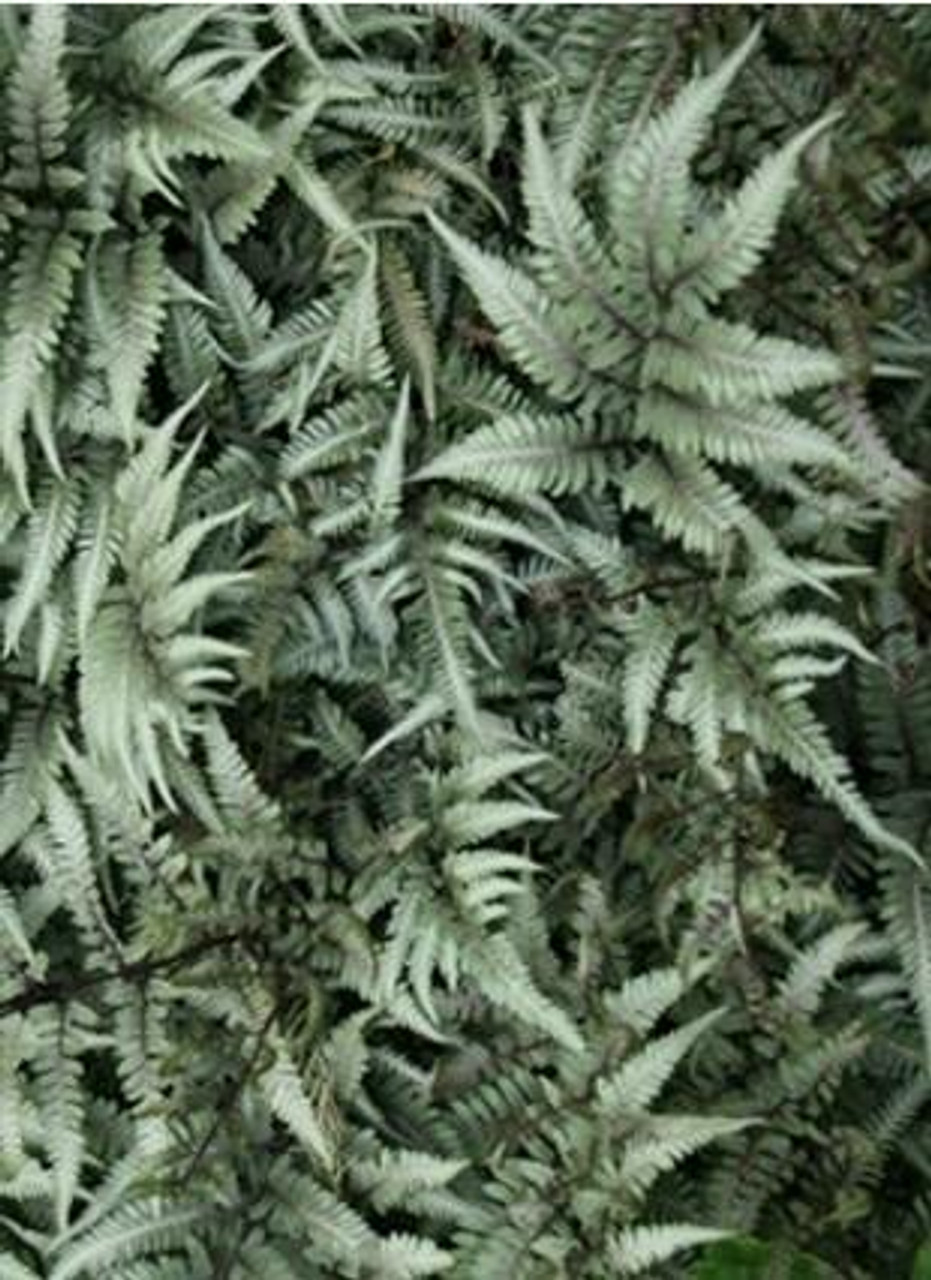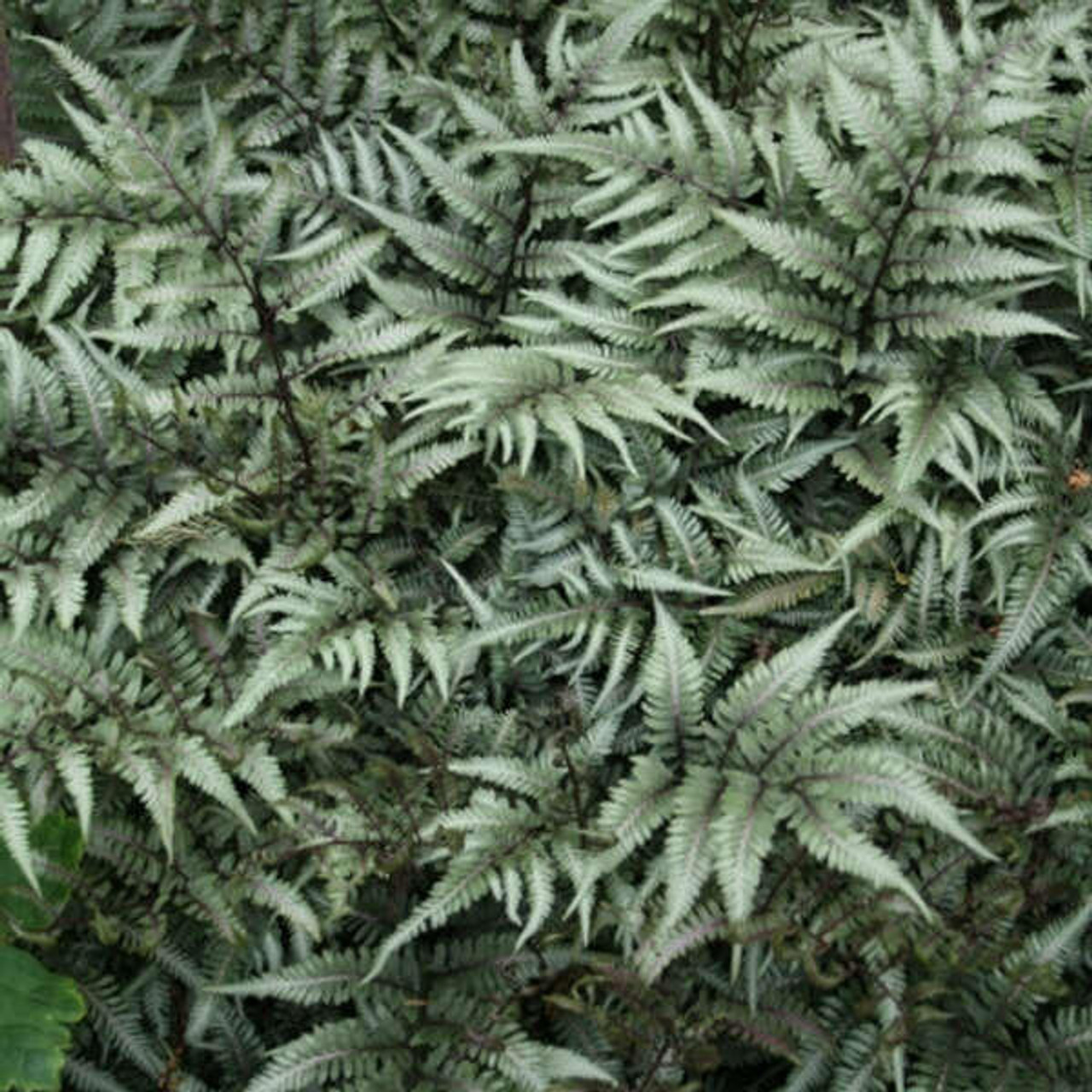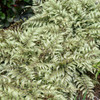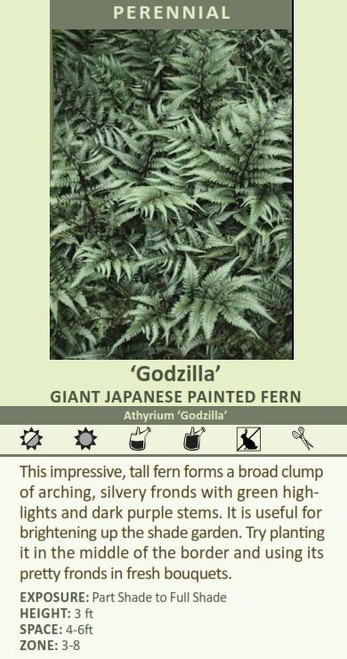Product Description
Athyrium 'Godzilla' (20)ct Flat
Common Name: Giant Japanese Painted Fern
Like Athyrium n. ‘Pictum’ on steroids, this giant painted fern was discovered at Plant Delights Nursery in the mid-90s and is thought to be a sporeling of ‘Pictum’ and the Lady Fern.
It forms a massive, arching clump of silvery fronds with green highlights and dark purple stems. Like the Lady Fern, ‘Godzilla’ spreads slowly where it is happiest in moist, loamy soils.
Athyrium grows best in moist soil with a neutral to moderately acidic pH. Partial to full shade is best. To protect the crowns and tender shoots in the spring, it is best to leave the old fronds on the plant over the winter. They can be removed in the spring when the new fronds reach 6 inches tall. If division is necessary, do so in the spring.
Height: 3.0 Feet
Spread: 4.0-6.0 Feet
Hardiness Zones: 3,4,5,6,7,8
Foliage Color: Green shades, Silver/grey shades
Part Shade (4-6 hrs. Direct Sun) - Full Shade (< 4 hrs. Direct Sun)
Average to Consistent Water Needs
Poor to Fertile Soil Quality
Rabbit Resistant
Growth Rate: Medium
Border Plant, Container, Cut Foliage, Attractive Foliage
Prepare to be amazed by the colossal beauty of Athyrium 'Godzilla'! This aptly named giant Japanese painted fern truly lives up to its moniker, boasting massive fronds that bring a prehistoric feel to any shade garden. With its striking silvery-green foliage and contrasting dark purple stems, 'Godzilla' is a showstopper that demands attention.
Athyrium 'Godzilla' is a deciduous fern that forms a majestic mound of arching fronds, reaching up to 3 feet tall and 4 feet wide. Its silvery-green fronds are adorned with dark purple stems, creating a stunning contrast that adds depth and dimension to shady landscapes. This slow-growing fern is a true investment, gradually developing into a breathtaking focal point that will be the envy of your gardening neighbors.
- Hardiness Zones: 3-8
- Exposure: Part shade to full shade
- Mature Size: 3 feet tall x 4 feet wide
- Soil: Moist, well-drained soil
- Water: Water regularly, especially during hot, dry periods
- Maintenance: Low maintenance, deer and rabbit resistant
Planting
- Choose a location: Select a spot in your garden that receives.
- Prepare the soil: Amend the soil with organic matter to improve drainage and fertility.
- Dig a hole: Dig a hole twice as wide as the root ball and just as deep.
- Plant the fern: Carefully remove the fern from its pot and place it in the hole, ensuring the crown is level with the soil surface.
- Backfill the hole: Fill the hole with amended soil, gently firming around the roots.
- Water thoroughly: Water deeply after planting to settle the soil.
Care
- Watering: Water regularly, especially during hot, dry periods, to keep the soil consistently moist but not waterlogged.
- Fertilizing: Fertilize in spring with a balanced slow-release fertilizer.
- Pruning: Remove any dead or damaged fronds in early spring.
- Dividing: Divide mature plants in early spring or fall to maintain vigor and control size.
Bring home this prehistoric giant and let Athyrium 'Godzilla' rule your shade garden!
Other Details
The most important part of the plant is its root system. Healthy roots are the foundation of a healthy, vibrant plant. The type of plug container used is based on the specific needs of the plants. Perennials offered as bare root traditionally perform better when planted as bare root.Planted in a specialized mix, potted plants have well established root systems. Top growth stage will vary depending on the current life cycle and time of year when shipped. In Winter and early Spring dormant plants may be shipped. Dormant plants may be planted right away, even before the last frost date.
Most bare root varieties are field grown for at least one season, though Hemerocallis and Hosta are grown for two seasons. The bulk of the soil is removed during the harvesting process and the tops of most varieties are trimmed back to the crown. They are graded, packed in shredded aspen or sphagnum moss and stored in freezers until ready to be shipped.
See our Container Sizes and Bare Root Perennials pages for more information.
Plant information and care is provided in the Overview section, Plant Genus Page and general information is provided in the Planting Care & Guides. Additional questions can be asked on each Plant page.
Plant Spacing: Using the maximum mature spread or width of a plant to guide spacing, ensures space to grow to full size. To fill an area sooner, plant them closer together. Just remember, future thinning or transplanting may be needed.
Water: Keep a close eye on newly planted perennials, especially throughout the first growing year. Most early plant loss is due to too much or too little water!















